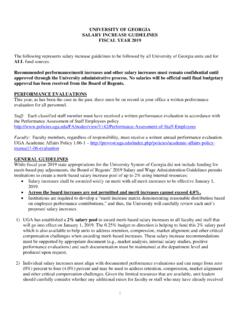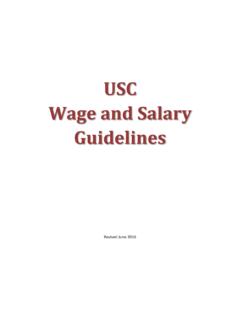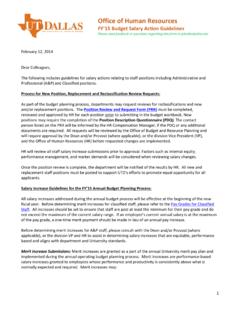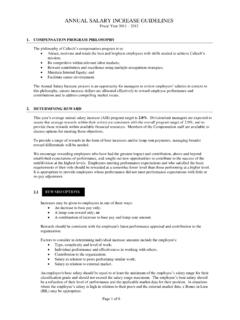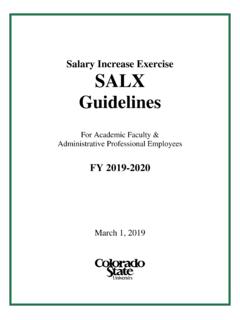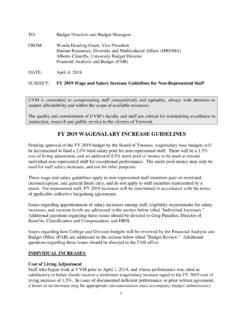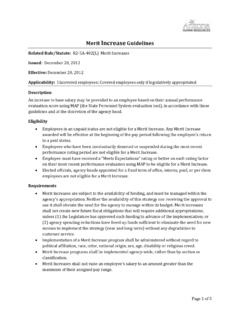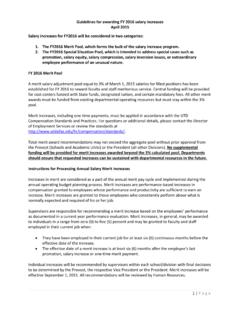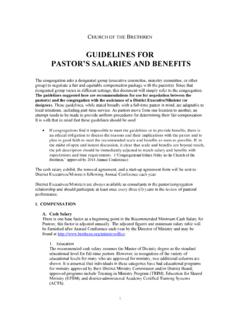Transcription of COMPENSATION PROGRAM GUIDELINES for the Non …
1 Version (01/19/16) 1 COMPENSATION PROGRAM GUIDELINES for the Non-Represented Administrative/Professional (A/P) Employees Purpose The following COMPENSATION GUIDELINES are intended to provide a framework for the administration of COMPENSATION for non-represented staff employees by describing typical salary transactions and clarification of who has authority to approve salary changes. This PROGRAM covers the following employee groups: Management (MA), Non-Represented Exempt (NE), Non-Represented Non-Exempt (NN), and Non-Represented Clerical (NC) employees. Table of Contents COMPENSATION Philosophy PROGRAM Elements Responsibilities General salary Transactions Posted Position salary Offers annual Merit Increases Vacant and New Jobs Promotions and Demotions Transfers and Career Developmental Assignments Special salary Amounts salary Equity Adjustments Market Reviews Reorganizations Other COMPENSATION Transactions Job Change Reason Matrix Page Number 2 2 3 4 4 4 6 7 9 9 10 12 14 DISCLAIMER This document is intended as a summary of the PROGRAM features.
2 It is not intended to and does not create an express implied contract of employment. It does not contain any promises by the University and the University is not legally or otherwise bound by it. Wayne State University reserves the right to amend, modify, or terminate this PROGRAM at any time and in any manner. The COMPENSATION PROGRAM GUIDELINES for the Non Represented Administrative/Professional (A/P) Employees are not intended to apply, either directly or indirectly, to employees covered by collective bargaining agreements with the university. Please refer to the collective bargaining agreement for guidance relative to represented employees. Version (01/19/16) 2 COMPENSATION Philosophy The Wayne State University Non-Represented A/P COMPENSATION PROGRAM is designed to achieve the following objectives: To support University mission and goals. To deliver market competitive COMPENSATION to attract, retain, and motivate a high performing workforce. To utilize a total rewards approach to ensure that our combined COMPENSATION and benefits programs are positioned appropriately to the market.
3 To provide a COMPENSATION PROGRAM that is flexible and fiscally responsible. To provide its employees with COMPENSATION GUIDELINES which are clear and easy to administer. To monitor and incorporate market practices. To ensure that managers conduct regular performance reviews and administer merit salary increases to promote the linkage between pay and performance. PROGRAM Elements The key terms used in this document include: salary Structure is a set of salary bands that encompass the competitive salary rates in the marketplace. Each salary Band is defined by minimum and maximum dollar values. Under the band structure, intraband reporting is prohibited ( , managers and their subordinates in the same reporting line cannot be in the same salary band). Job is a collection of tasks, functions and responsibilities that an employee is responsible to conduct. Each Job Title captures a unique job role and has a corresponding Job Description (a formal document, approved by TCW that describes the purpose, essential functions, scope, minimum qualifications and required knowledge, skills and abilities of the job title).
4 Position is a job assigned a specific position number, typically occupied by a single individual. Version (01/19/16) 3 Responsibilities The Executive of a School, College or Division (S/C/D), is the top leadership position in the S/C/D ( Unit ), who has the authority to approve all COMPENSATION transactions covered by these GUIDELINES . The Provost and Senior Vice President may delegate authority on COMPENSATION matters to Deans of the Schools and Colleges. One over one approval required for all COMPENSATION activities. Vice President approval may be required for certain COMPENSATION actions, as specified in the detailed sections of these GUIDELINES . The Unit Executive has the authority and responsibility to: Review and approve COMPENSATION decisions ( , new hire offers, promotions/demotions, transfers, etc.) in his/her Unit. Ensure that all managers maintain a thorough knowledge of the COMPENSATION GUIDELINES so all managers can uniformly and consistently administer the PROGRAM in his/her Unit.
5 Consult with Human Resources on COMPENSATION matters as appropriate. Ensure that their managers conduct regular performance reviews and link COMPENSATION decisions to employee performance. Ensure that all employees in their Unit have a current and accurate job description by implementing regular updating of all job descriptions, at least annually. Address internal equity concerns or individual employee questions over COMPENSATION in his/her Unit. The Total COMPENSATION and Wellness (TCW) Department responsibilities will include: salary Planning & PROGRAM Development - Design COMPENSATION PROGRAM elements, including base salary and variable pay - Prepare recommendations for changes in COMPENSATION administration salary Structure Development - Recommend annual salary band structure and merit budgets - Analyze jobs and their salary bands periodically to confirm competitiveness - Review organizational structure to ensure no intraband reporting, ( , managers and their subordinates in the same reporting line should not be in the same salary band).
6 New Job Creation/Market Reviews - Analyze and evaluate new jobs or jobs that have changed - Assist Units with development of job descriptions and reorganizations - Conduct market pricing if available or use slotting to place jobs into the salary band hierarchy Consult with Management - Consult with University Units to assist them in making sound COMPENSATION decisions - Develop and administer COMPENSATION GUIDELINES - Work with University Units to ensure that COMPENSATION GUIDELINES are utilized - Review exceptions to COMPENSATION GUIDELINES and provide guidance to management - Monitor and report on salary transactions in the various Units. Version (01/19/16) 4 Posted Position salary Offers A salary offer for a posted position that has gone through a competitive selection process is defined as the salary offered to the selected candidate (internal or external). The starting pay should be based on market data and: - within a range equivalent to +/- 20% of the market rate of pay - based on the candidate s experience and skills or competencies - must be between the minimum and the maximum of the job s salary band - internal salary equity analysis Upon request, TCW will determine a reasonable range of pay for the salary offer.
7 TCW will work with the Unit and Client Services to ensure that job postings reflect the assigned salary band. The decision about the amount of the salary offer must be approved by the Executive of the S/C/D based on available funding within the Unit s budget and sent to the Client Services Director for final salary approval and processing. The University permits limited use of sign-on bonuses for new hires which require Vice Presidential approval. A posted position salary offer must be documented by completion of a salary Offer Spreadsheet Form which is signed by the Executive of the S/C/D. A copy must be sent to the Client Services Director for final approval of the proposed salary and processing prior to employee notification. annual Merit increase A merit increase is defined as an increase to an employee s base salary which reflects the individuals performance, or merit . A common annual increase date is utilized for all Non-Represented employees; however, such annual salary adjustments are not automatic.
8 The amount of an employee s annual merit increase depends on the overall merit budget and the individual s performance review rating. If an employee is close to the salary band maximum, he/she may receive a partial merit increase which adjusts the base salary to the salary band maximum. Any remaining merit increase , which would cause the base salary to exceed the salary band maximum, will be paid as a merit lump sum payment amount (which is eligible for retirement contributions). Individuals may fall below the minimum of the salary band and units are not required to bring employees up to the salary band minimum. Vacant and New Jobs (See EXHIBIT 1) A vacant job is defined as a job with a prior incumbent and a new job is defined as a job with no prior incumbent. The Unit should explore whether a job title and job description exists in the Unit that sufficiently matches the duties and qualifications needed by the hiring Unit. TCW will work with the Unit and Client Services to determine whether a new job is properly characterized as Non-Represented before any internal promotion or external job posting.
9 If a job title and job description DOES exist within the Unit, then the Unit may promote or transfer an employee from within that Unit or may post the position. If a job title and job description DOES NOT exist within the Unit, then the Unit will develop a Job Description and TCW will conduct a Market Review. Upon approval by TCW to establish the job title within the Unit, the position must be posted. Version (01/19/16) 5 TCW Market ReviewPrepare Job DescriptionMarket Price the JobAssign to salary BandGO TO Exhibit 2 EXHIBIT 1 Action Steps for New or Vacant JobsNEW JOBVACANT JOBDoes a job title and job description exist within the Unitthat matches?NOYESUse an ExistingJob TitleAndJob DescriptionCreate New Job TitleAndJob DescriptionPost the Job on WSU On-Line Hiring SystemNo Intraband Reporting is AllowedNo Intraband Reporting is Allowed Version (01/19/16) 6 Promotions and Demotions If an employee is promoted from a non-rep A/P job to a job title in a higher salary band that is not the result of a job posting this promotion is subject to the following GUIDELINES : - A promotional salary increase is up to 10% of base pay (or up to 15% if the promotion involves a move across 2 or more salary bands).
10 - In no event shall the employee be paid less than the salary band minimum or more than the salary band maximum for the new job. - A promotional salary increase shall be effective on the date the new job duties begin. - An employee can only be promoted once in a twelve (12) month period. - A promotion must be supported by evidence such as assuming greater responsibility or moving to a job with a larger scope; taking on new responsibilities that require higher skills or experience, etc. - Internal equity analysis completed in conjunction with Client Services prior to offer. - Vice President approval is required for any proposed promotional increase amount that exceeds the 10% (single band) or 15% (multiple bands) and takes the salary of the employee above the minimum of the new band. A temporary promotion is defined as a promotion where the employee assumes the FULL duties of another job in a higher salary band and is subject to the following GUIDELINES : - The assignment is for a temporary time period ( , for a period of greater than one (1) month but less than one (1) year).





